
Euphorbia is a very large and diverse genus of flowering plants, commonly called spurge, in the spurge family (Euphorbiaceae). "Euphorbia" is sometimes used in ordinary English to collectively refer to all members of Euphorbiaceae, not just to members of the genus. Some euphorbias are commercially widely available, such as poinsettias at Christmas. Some are commonly cultivated as ornamentals, or collected and highly valued for the aesthetic appearance of their unique floral structures, such as the crown of thorns plant. Euphorbias from the deserts of Southern Africa and Madagascar have evolved physical characteristics and forms similar to cacti of North and South America, so they are often incorrectly referred to as cacti. Some are used as ornamentals in landscaping, because of beautiful or striking overall forms, and drought and heat tolerance.
Susan Carter Holmes is a botanist and taxonomist at the Royal Botanic Gardens, Kew. She discovered and catalogued more than 200 plants of the family Euphorbiaceae, particularly of the succulent East African members of the genera Euphorbia and Monadenium, as well as about 20 Aloe species. All plants and articles are published under her maiden-name Susan Carter.

Euphorbia candelabrum is a succulent species of plant in the family Euphorbiaceae, one of several plants commonly known as candelabra tree. It is closely related to 3 other species of Euphorbia in particular; Euphorbia ingens in the dry regions of South Africa, Euphorbia conspicua from western Angola, and Euphorbia abyssinica which is native to a number of countries including Sudan, Eritrea, Djibouti, Ethiopia and Somalia.

Euphorbia poissonii, also known as Euphorbia poissoni and, incorrectly as Euphorbia poisoni is a highly irritant and toxic succulent member of the large and varied spurge family of plants. It is native to northern Nigeria, where local farmers extract its latex for use as a pesticide. Its powerfully irritant and pain-producing nature mandates use as a fencing plant.

The Euphorbiaceae are a large family, the spurge family, of flowering plants. In common English, they are sometimes called euphorbias, which is also the name of a genus in the family. Most spurges such as Euphorbia paralias are herbs, but some, especially in the tropics, are shrubs or trees, such as Hevea brasiliensis. Some, such as Euphorbia canariensis, are succulent and resemble cacti because of convergent evolution. This family occurs mainly in the tropics, with the majority of the species in the Indo-Malayan region and tropical America a strong second. A large variety occurs in tropical Africa, but they are not as abundant or varied as in the two other tropical regions. However, the Euphorbiaceae also have many species in nontropical areas such as the Mediterranean Basin, the Middle East, South Africa, and the Southern United States.
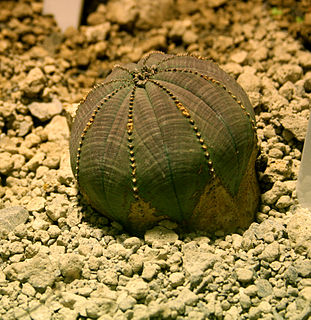
Euphorbia obesa is a subtropical succulent species of flowering plant in the genus Euphorbia. It comes from South Africa, especially the Cape Province. Sometimes referred to as the baseball plant.

Euphorbia caput-medusae is a plant of the genus Euphorbia that occurs in and around Cape Town, South Africa.

The North-West University Botanical Garden on the Potchefstroom Campus of the North-West University (NWU) is the only botanical garden in the North West Province of South Africa. The Garden spans just under three hectares and is open to the public.

Euphorbia flanaganii, commonly known as Transkei medusa's head, is a succulent plant that belongs to the family Euphorbiaceae. Due to the breadth of the Euphorbiaceae, little research specific to E. flanaganii has been conducted.
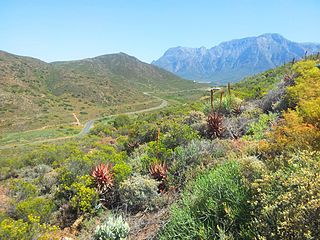
Robertson Karoo is a semi-arid vegetation type, restricted to sections of the Breede River Valley, Western Cape Province, South Africa. It is a subtype of Succulent Karoo and is characterised by the dominance of succulent plant species, and by several endemic plants and animals.

Euphorbia schinzii is a perennial Southern African, dwarf flowering plant belonging to the family Euphorbiaceae. It is found on rocky slopes, growing among rocks. Variable in form, it occurs in South Africa, Zimbabwe, Botswana, Mozambique and Malawi, at an altitude between 100 and 1500 meters. The genus Euphorbia is large, with over 2000 species of extremely diverse size and appearance, and with a global distribution.

Euphorbia tuberosa, commonly known as '"milkball/melkbol"' or '"wilderamenas"', is a variable geophytic plant of the family Euphorbiaceae, indigenous to the western parts of South Africa.
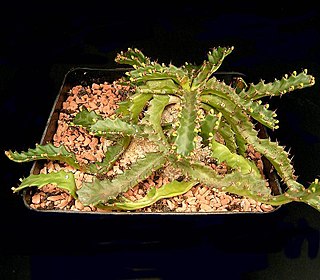
Euphorbia stellata is a species of flowering plant in the spurge family (Euphorbiaceae) endemic to the Eastern Cape of South Africa.
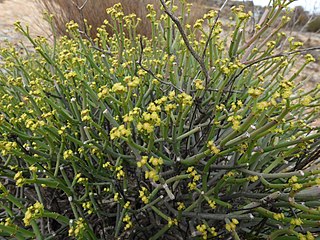
Euphorbia rhombifolia is a species of flowering plant in the Euphorbiaceae family. It is native to Namibia and South Africa, where it is widespread in clay-rich soils, extending as far east as Kwazulu-Natal.
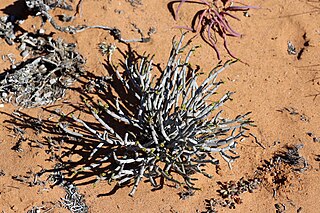
Euphorbia burmannii is a species of Euphorbia indigenous to Namibia and South Africa, where it is widespread in sandy soils, extending southwards to the Cape Peninsula and as far east as Grahamstown.
The Baynes Mountains are a mountain range in Namibia.
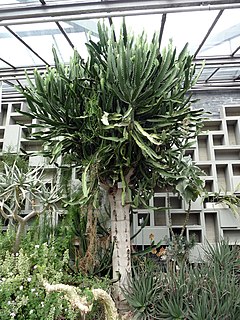
Euphorbia triangularis, commonly known as river euphorbia, chandelier-tree or tree euphorbia, is a species of plant in the family Euphorbiaceae native to southern Africa.

Euphorbia groenewaldii is a species of flowering plant in the family Euphorbiaceae native to southern Africa. It is listed as endemic to and Critically Endangered in South Africa due to habitat destruction and overcollection. Kew's Plants of the World Online also lists it as native to Mozambique.

Euphorbia grandidens, commonly known as valleybush euphorbia or large-toothed euphorbia, is a species of plant in the family Euphorbiaceae native to southern Africa.
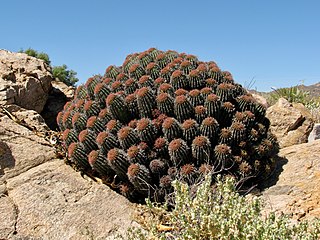
Euphorbia stellispina is a species of flowering plant in the family Euphorbiaceae endemic to southern Africa. It is locally known in Afrikaans as skaapnoors, sterretjie-noors, or Karoo noorsdoring. Euphorbia stellispina grows in rocky areas of karroid shrublands.


















